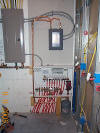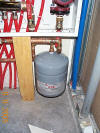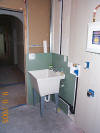 September 9, 2005 - Wednesday - The radiant floor heating system is now
operational! This picture shows an overall view of our
Ipex zone control panel, with the SH-14
Seisco on demand "micro boiler" mounted to
the wall above the zone control panel.
September 9, 2005 - Wednesday - The radiant floor heating system is now
operational! This picture shows an overall view of our
Ipex zone control panel, with the SH-14
Seisco on demand "micro boiler" mounted to
the wall above the zone control panel.
 September 9, 2005 - Wednesday - As mentioned previously, our radiant floor
heating system is a "closed loop" system. This means the water in the
floor system never leaves the tubes in the floor and is simply pumped around and
around the system. An open loop system is one where the hot water being
used by the occupants of the home moves through the floor and then out to a
shower, faucet, or other location to provide hot water for the home's residents.
Even though open loop systems are legal in most areas, there is still some
question regarding is it desirable for water that has been in a floor system for
a long time to then be used by a home's residents. Since there still are
some questions, we opted for a closed loop system. A good design practice
for a closed loop system is to have a "make up" water connection from the home's
main water supply feeding the closed loop system. This is a convenient way
for the installer to initially fill the system, it guarantees the system is
always completely full, and its a great way to control how much pressure the
system runs under.
September 9, 2005 - Wednesday - As mentioned previously, our radiant floor
heating system is a "closed loop" system. This means the water in the
floor system never leaves the tubes in the floor and is simply pumped around and
around the system. An open loop system is one where the hot water being
used by the occupants of the home moves through the floor and then out to a
shower, faucet, or other location to provide hot water for the home's residents.
Even though open loop systems are legal in most areas, there is still some
question regarding is it desirable for water that has been in a floor system for
a long time to then be used by a home's residents. Since there still are
some questions, we opted for a closed loop system. A good design practice
for a closed loop system is to have a "make up" water connection from the home's
main water supply feeding the closed loop system. This is a convenient way
for the installer to initially fill the system, it guarantees the system is
always completely full, and its a great way to control how much pressure the
system runs under.
The observant reader should be thinking at this point "is it really a closed
system if the home's water system is directly connected to the radiant floor
system?" This would be a good question! To make sure the water from
the floor system never gets back into our domestic water system we have
installed a double check valve backflow prevention device. We chose the
industry standard model 009QT from Watts
Regulator Company. This assembly can easily be seen in this picture
above and to the right of the dryer vent.
Next we install an adjustable pressure reducing valve after the backflow
prevention assembly. If the pressure in our radiant floor system ever
falls below the setting of the pressure reducing valve, the valve allows water
to flow into the radiant floor system until the pressure in the radiant floor
system matches that of the valve setting. This allows us to control the
pressure at which our radiant system operates, and it always keeps our system
completely full. We chose the model 3350-T from
Taco. The pressure setting of this
valve comes preset from the factory at 12 psi (pound per square inch) which will
be fine for our system. If we ever want to change the pressure of our
system the Taco valve can be set to another pressure in a matter of seconds.
This valve with its green top can be easily seen in this picture directly below
the electrical panel.
To complete the water make system, it is fed from one of the ports on our
wonderful Vanguard manabloc, so to
the home's domestic water system it just looks like another cold water faucet.
Neat!
 September 9, 2005 - Wednesday - For optimum performance, it is important to
remove all the air bubbles possible from the water in our radiant floor
system. We remove most of the air in the system by using the proper
filling technique when we initially fill the system with water. Even with
our best effort, there is still many "micro" bubbles left in the system after
the initial fill. To help this situation we install an "air eliminator"
which will remove even the smallest of micro bubbles. We chose the
Spirovent Jr. from Spirotherm. The
Spirovent Jr. is the brass device in the center of this picture.
September 9, 2005 - Wednesday - For optimum performance, it is important to
remove all the air bubbles possible from the water in our radiant floor
system. We remove most of the air in the system by using the proper
filling technique when we initially fill the system with water. Even with
our best effort, there is still many "micro" bubbles left in the system after
the initial fill. To help this situation we install an "air eliminator"
which will remove even the smallest of micro bubbles. We chose the
Spirovent Jr. from Spirotherm. The
Spirovent Jr. is the brass device in the center of this picture.
 September 9, 2005 - Wednesday - Another "best practice" for installing radiant
heating systems is to include an expansion tank in the system. The purpose
of the expansion tank is to provide the water in the system a place to go when
it expands from being heated, and then to replace this water back into the
system when the water cools. The expansion tank has a bladder inside of it
that is pressurized via a normal valve stem fitting on the bottom of the tank.
The pressure of the bladder is usually set to the same pressure as that of the
system, which in our case is 12 psi. Lucky for us the unit comes from the
factory pre-pressurized to 12 psi. The unit we chose is the model 15 from
Amtrol. Another great American
company still actually making their products in the USA!
September 9, 2005 - Wednesday - Another "best practice" for installing radiant
heating systems is to include an expansion tank in the system. The purpose
of the expansion tank is to provide the water in the system a place to go when
it expands from being heated, and then to replace this water back into the
system when the water cools. The expansion tank has a bladder inside of it
that is pressurized via a normal valve stem fitting on the bottom of the tank.
The pressure of the bladder is usually set to the same pressure as that of the
system, which in our case is 12 psi. Lucky for us the unit comes from the
factory pre-pressurized to 12 psi. The unit we chose is the model 15 from
Amtrol. Another great American
company still actually making their products in the USA!
 September 9, 2005 - Wednesday - Here is a shot of one of our test thermostats.
September 9, 2005 - Wednesday - Here is a shot of one of our test thermostats.
 September 9, 2005 - Wednesday - Since exterior painting is coming up very soon,
we thought it would be nice to have a place to clean brushes, etc. To that
end Jeffrey installed the utility sink in the laundry room. We chose the
model 15F "Utilatub" from Mustee & Sons.
The faucet is model 2121 from Delta.
Two great American companies!
September 9, 2005 - Wednesday - Since exterior painting is coming up very soon,
we thought it would be nice to have a place to clean brushes, etc. To that
end Jeffrey installed the utility sink in the laundry room. We chose the
model 15F "Utilatub" from Mustee & Sons.
The faucet is model 2121 from Delta.
Two great American companies!
Back to Summer Breeze Lot 27
Gallery

![[Company Logo Image]](../../images/gmb_hires_10_percent.gif)